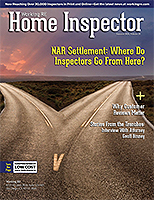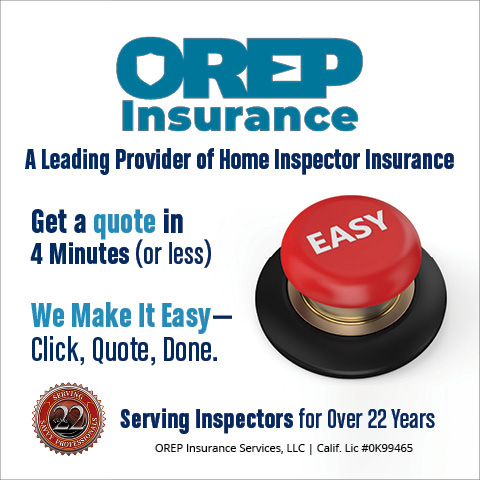 | > E&O/GL Insurance for Home Inspectors Competitive Rates, Broad Coverage, Free Risk Management, online inspection support for tough questions, discounts on education and more… Professional Coverage, Competitive Pricing Shop OREP today! |
Should Inspectors Write ‘Monitor’ in Their Reports?
by Greg Nelms
To monitor or not to monitor, that is the question. Many states now regulate the profession of home inspections and require the home inspector to follow a “standard of practice.” Home inspection professional organizations also have standards of practice that their members must follow. These standards spell out what is to be inspected, any exclusions, and what must be included in the inspection report. It is important to note in states in which home inspections are regulated, the state’s standards of practice will generally supersede any professional organization’s standards. Within these standards, most compel the home inspector to inform the client of any material defect requiring repair, replacement, further evaluation by a professional, or MONITORING in the written report.
“Monitoring” in a home inspection report does not serve the client or the inspector. If the inspector feels it is necessary to report the issue within the report, then it is best practice to recommend that it be repaired or at least evaluated by a professional. This is even more important when dealing with health or safety concerns. Being realistic, it does not help the client (now new homeowner) to “monitor” a foundation crack only to discover it needs several thousand dollars of repair within the first year of new ownership. You can bet the repair contractor will swear this was obvious and in need of repair during the home inspection.
In a recent Working RE Home Inspector magazine article, a claim against a home inspection company and the home inspector for a deck collapse was reported by Isaac Peck. In this situation, the home inspector found defects with the deck’s construction but failed to convey the severity of these defects and the need for repair.
Excerpt from inspection report:
Safety Issue: The deck railing is loose. It is recommended that this be repaired for improved safety.
Improve: The deck should be painted or stained to improve its durability.
Monitor: The deck is showing signs of wear and age. Some improvements may be desired, but it is generally serviceable.
Monitor: The deck does not appear to be lag bolted to the exterior of the home. Current building practices require that decks be properly secured to the home with lag bolts. If this home is over ten years old, it may have been built prior to these requirements.
(story continues)
There are several problems with the way this deck was described in the written report. For example, the statement this deck was in a “generally serviceable condition” is incorrect with the observed loose railing and lack of being properly attached to the house. Documented injuries and even deaths have been reported with deck collapse and loose hand/guard rails. Both of these are serious safety issues and should have been reflected in the report with statements such as: “immediate evaluation and repair by a deck professional” and “deck must be taken out of service until it can be made safe for use”.
Further, the report stated, “Monitor: The deck does not appear to be lag bolted.” Exactly how is a homeowner supposed to “monitor” this condition?
The report does not detail how this is to be accomplished. Are the homeowners supposed to check the connection before every use? Are they to measure any separation between the house and the ledger? (Incidentally, the deck collapsed less than 30 days after they closed the scroll, and all eight people on the deck were injured, with some receiving permanent personal injuries). Remember, most homeowners do not have the knowledge or expertise to determine what they are monitoring and when it becomes a need for repair. If this inspector had removed the word “monitor” and replaced it with “repair”, he may have been heralded and thanked by the clients for potentially saving them from serious injury or even death. Instead, the cost of defending against the claim and the payouts are over a million dollars. Since the homeowner’s insurance company was also sued and paid a quarter of a million dollars to the plaintiffs, it is conceivable this insurance company may also sue the home inspection company and inspector to recoup their loss.
Speaking of insurance, a question is brought to mind. Was this company and inspector sufficiently insured? Most home inspection companies are not adequately covered for this type of extreme claims or costs. If the company was insured for $500,000 per occurrence per year, then that figure is what the insurance company is obligated to pay. Anything over this figure is the responsibility of the inspection company. What happens if a second claim is filed within the policy dates? Since the insurance monies have been used, it is likely the home inspection company could be fully responsible for any further claims.
When writing a home inspection report and before including a statement to “monitor” the condition, a home inspector should stop and think about what could happen if the condition changes and requires repair or replacement, after all, unless your crystal ball is in perfect working order, one cannot foretell the future. My crystal ball cracked years ago and has never worked again. It is better to protect your client by insisting a qualified professional further evaluate the item to ensure the component or system does not warrant repairs or replacement. By doing this, the home inspector also protects themselves from the traumatic situation of defending a nightmarish claim.
About the Author
Greg Nelms is the author of this article. Mr. Nelms is the owner of Nelms Inspections and has been a home inspector for 35 years. Mr. Nelms is also an instructor for the home inspection courses required by the State of New Jersey to obtain a home inspection license. He is a guest educational speaker for seminars across the country and often is asked to specifically teach on the subject of report writing. He can be reached at nelmsinspections@gmail.com.
OREP Insurance Services, LLC. Calif. License #0K99465


